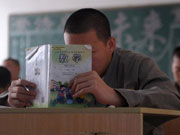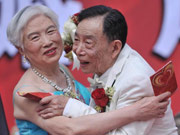I. Right to Development
China's economy was stable and improved in 2013, better benefiting the Chinese people. The material and cultural needs of the people have been better satisfied, and the Chinese people's right to development has been better guaranteed.
The people's living standards are steadily on the rise. In 2013 China maintained a GDP growth rate of 7.7 percent, which was relatively fast. The annual per capita net income for rural residents reached 8,896 yuan, up 9.3 percent in real terms; the annual per capita disposable income for urban residents was 26,955 yuan, an increase of 7 percent in real terms; and the rise in the Consumer Price Index (CPI) remained at the low level of 2.6 percent. China's annual grain output in 2013 reached 601.935 million tons; the number of civil vehicle holding reached 137.41 million; the number of fixed phone lines was 266.99 million, and the number of mobile phone users increased by 116.96 million to 1,229.11 million. The number of domestic tours totaled 3.26 billion, and the number of trips abroad made by Chinese citizens reached 98.19 million, up 10.3 percent and 18 percent, respectively, over the previous year. Among them, the number of trips abroad for private purposes reached 91.97 million, an increase of 19.3 percent.
Employment is expanding through various channels. Despite great employment pressure, China adheres to the employment priority strategy, taking stable growth and ensuring employment as the threshold of a proper economic range, and creating more and better-quality jobs on the basis of development. China attaches great importance to the development of labor-intensive industries, small and medium-sized enterprises (SMEs), private enterprises and service industries that can create more jobs. In 2013 some 13.1 million urban jobs were created, an increase of 440,000 over 2012, and the registered urban unemployment rate stayed at 4.1 percent, which was relatively low. The government also provided skills training. As many as 20.49 million people participated in vocational training with government subsidies in 2013, among whom 12.275 million participated in employment skills training, 2.082 million attended entrepreneurship training, 5.487 million took part in job skills upgrading training and 646,000 received other types of training. The number of laid-off workers receiving training reached 3.98 million. China endeavors to facilitate the transfer to non-agricultural jobs of rural people, organized more than 20,000 special job fairs for migrant workers in 2013, and trained 9.384 million farmers. The government attaches ever-more importance to the employment of young people, especially college graduates. Through employment guidance services, campus recruitment activities, the "Employment Promotion Plan for Unemployed College Graduates" and other measures, China encourages college graduates to find jobs and start businesses in various forms and through various channels.
The basic rights of workers are guaranteed. In 2013 a total of 27 provinces (autonomous regions, municipalities directly under the central government) raised their minimum wage standards, averaging a 17 percent annual hike. The average monthly income of rural workers employed away from their homes was 2,609 yuan, an increase of 319 yuan over 2012. Community-level trade unions and organizations for safeguarding workers' rights continue to maintain a relatively rapid pace of development. By the end of 2013 the formation rate of labor dispute mediation organizations in townships and subdistricts had reached 60 percent, an increase of 10 percent year on year; the formation rate of labor dispute arbitration committees had reached 91.6 percent; and the rate of labor dispute arbitration courts nationwide was 72.7 percent, up 20 percent year on year. The number of community-level trade unions increased to 2.77 million, up 4 percent over 2012; a total of 1.298 million effective collective contracts were signed throughout the country, involving 3.64 million enterprises and 160 million employees, up 6 percent, 18 percent and 9 percent over 2012, respectively. Assistance to impoverished workers was strengthened, benefiting 7.739 million people in 2013.
The government-subsidized housing projects continue to make progress. In 2013 the central government appropriated 200.3 billion yuan to help facilitate the building of government-subsidized housing and the rebuilding of dilapidated areas in all regions, and the improvement of supporting infrastructure. In the same year, construction of 6.6 million government-subsidized housing units and housing units in dilapidated areas started, and 5.4 million were basically finished. By the end of the year China had provided housing for another 36 million urban families. Cities at prefectural level and above had all worked out the conditions, procedures and waiting rules for government-subsidized housing applications by migrant workers, and the government-subsidized housing system had expanded to cover not only households with permanent urban residency but all the resident population in urban areas. China continued to promote the renovation of rural housing, renovating 2.66 million dilapidated rural houses in 2013.
Poverty reduction in rural areas is making steady headway. In 2013 the State Council issued Opinions on Promoting Rural Poverty Alleviation though Innovation Mechanisms. The central government appropriated 39.4 billion yuan on poverty reduction, an increase of 6.2 billion yuan over the previous year. In 2013 some 16.5 million rural residents got rid of poverty. The per capita net income for rural residents in the counties which are key targets of the government's poverty-reduction work reached 5,389 yuan, an increase of 787 yuan over 2012, or up 13.8 percent in real terms, a growth rate higher than that of the average level in China.
Education in poverty-stricken areas is better ensured, with bigger efforts being made in this regard. The expenditure from public finance on education in 2013 was 2187.7 billion yuan, up 3 percent over the previous year and mainly focusing on poverty-stricken rural areas. In the same year, the central financial body allocated 19 billion yuan of nutrition subsidies (including 2.218 billion yuan of government awards and subsidies for local pilot projects) and a special fund of nearly 10 billion yuan for building student dining halls. By the end of 2013 some 32.45 million rural students receiving compulsory education were benefiting from the nutrition subsidy policy. A total of 699 counties with contiguous poor areas (including 19 regiment-level entities of the Xinjiang Production and Construction Corps) in 22 provincial-level administrative areas carried out pilot projects, covering 95,900 schools and benefiting 32 million students; 529 counties in 19 provincial-level administrative areas launched pilot projects, covering 39,800 schools and benefiting 10.02 million students. The central government appropriated 10 billion yuan to upgrade rural schools with poor compulsory education conditions, with the focus on supporting the central and western rural areas, regions inhabited by ethnic minorities and poverty-stricken areas in improving their compulsory education conditions. The government allocated 16.5 billion yuan of funds from the central budget to support and lead the expansion of preschool educational resources in various regions, and to encourage the local governments to establish the preschool education financial assistance system so as to help impoverished children, orphans and disabled children receive preschool education; the government also provided 4.647 billion yuan of national grants to regular senior high schools, benefiting nearly 5 million students from poverty-stricken households; secondary vocational education was made free for all rural students, urban students whose majors are related to agriculture, and urban impoverished students, and the first- and second-grade students whose majors are related to agriculture or who are from impoverished households enjoy national grants. Thirty provinces (autonomous regions, municipalities directly under the central government) have released policies allowing the children of rural migrant workers who live in cities to take the local college entrance examinations, and 12 provinces and municipalities have started solving the problem.
Chinese citizens enjoy better and equal cultural services. China has continued to implement the National Construction Plan of Prefectural (City) Level Public Cultural Facilities, and has started the project of building demonstration sites of the national public service system, with 18 billion yuan of funds from the central and local public finance. By the end of 2013, with the cultural information resource-sharing program, China had built one service center at the national level, 33 sub-centers at the provincial level, 2,843 branches at the county level, 29,555 service stations at the township (subdistrict) level, and 602,000 service outlets at the incorporated village (community) level, and the service outlet coverage in some provinces (autonomous regions, municipalities directly under the central government) has extended to unincorporated villages; China has built 42,654 public electronic reading rooms, among which 27,706 are in townships, 2,282 are in subdistricts and 12,666 are in communities. In 2013 public libraries in China handed out 28.77 million library cards, 3.93 million more than in the previous year; the number of visits to libraries reached 492.32 million, 57.95 million more than in the previous year. In the same year, cultural institutes across the country organized 1.2884 million activities of various kinds to provide services to 434.31 million people. China has delivered public cultural resources directly to communities by implementing a series of major cultural projects benefiting the people, including providing radio and television services to every household of rural areas, launching the national cultural information resource-sharing program, building libraries for farmers, projecting free films in rural areas, and setting up township cultural stations. In 2013 the country' s total funds for culture, sports and media services provided by the public finances reached 251.956 billion yuan, an increase of 11.1 percent as compared with the previous year. The central government spent 17 billion yuan on the building of the public cultural service system, an increase of 1.6 billion yuan, or 10.55 percent over the previous year. The government uses incremental funds mainly at the community level and in rural areas, and provides preferential policies to former revolutionary base areas, areas inhabited by ethnic minorities, border areas and impoverished regions. Public cultural services have also been made more equitable.
 |  |

 16 Chinese films with a Cannes Award
16 Chinese films with a Cannes Award Best photos of the week (May 5 - May 11)
Best photos of the week (May 5 - May 11) Opening ceremony of 67th Cannes Film Festival
Opening ceremony of 67th Cannes Film Festival Silent world of EOD personnel
Silent world of EOD personnel Who is China's campus beauty queen?
Who is China's campus beauty queen? School for juvenile offenders behind bars
School for juvenile offenders behind bars Dance competition in Guizhou attracts more than 3,000 enthusiasts
Dance competition in Guizhou attracts more than 3,000 enthusiasts Golden wedding celebration in Chongqing
Golden wedding celebration in Chongqing China's J-11 fighters in actual-combat training
China's J-11 fighters in actual-combat training Six years after Wenchuan earthquake
Six years after Wenchuan earthquake 
Day|Week|Month